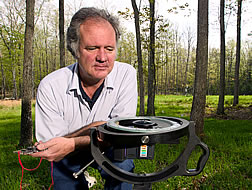This page has been archived and is being provided for reference purposes only. The page is no longer being updated, and therefore, links on the page may be invalid.
Read the magazine story to find out more. |
|
Shade Trees Can Protect Forage Plants
By Don ComisAugust 11, 2005
Giving forage plants, as well as animals, some shade from trees could be profitable for farmers, especially those farming marginal lands.
Soil scientist Charlie Feldhake, agronomist Dave Belesky and animal scientist Jim Neel of the Agricultural Research Service (ARS) are in their fourth year of raising lambs on oak and conifer silvopastures, combinations of forages and trees growing together on the same land. Belesky heads the team of scientists at the ARS Appalachian Farming Systems Research Center in Beaver, W.Va.
The scientists have found that some plants do better under moderate shade than in traditional open pastures. For example, Neel found that moderately shaded forage has more protein than forages on open pasture during the heat of July and August.
Silvopastures also seem to buffer drought and other seasonal extremes. Feldhake found that this buffering includes helping forage plants warm up about two weeks earlier than usual in the spring and to stay warm enough in late fall to hold off the hard frost for about two weeks. These effects are greatest under conifers.
This means silvopastures could provide another four weeks of forage growth and grazing time. The extra warmth in cool seasons comes from thermal radiation trapped and returned by the tree canopy.
The silvopastures are designed carefully, from the size of the trees to the amount and quality of sunlight allowed to reach the forest floor. The sites have instruments to monitor light, soil temperature, wind speed, precipitation and soil moisture.
The amount of light-buffering from tree shade has to be just right--not too much or too little. Researchers in other regions have found that tall fescue and orchardgrass grown in moderate shade yield better than those grown in heavy shade. Neel has found that pasture plants do best in up to 25 percent tree shade in the frequently cloudy Appalachian Region.
Read more about the research in the August 2005 issue of Agricultural Research magazine.
ARS is the U.S. Department of Agriculture's chief scientific research agency.


